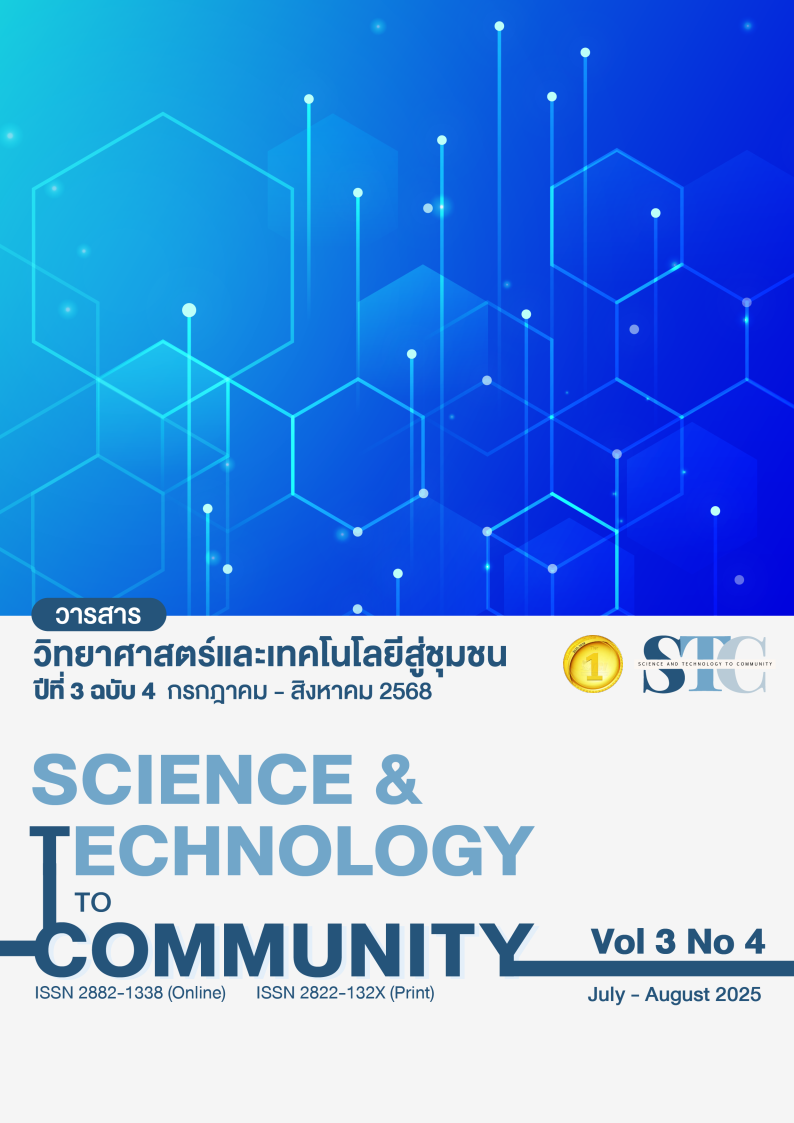Study of Physical-Chemical Characteristics and Microorganisms from the Fermented Juice of Mangifera Indica L.
DOI:
https://doi.org/10.57260/stc.2025.1068Keywords:
Mangifera indica L., FermentationAbstract
This experiment aimed to study of fermented juice from Mangifera indica L to be used as a dietary supplement for livestock. All treatments were assigned in a completely randomized design (CRD) consisted of 5 treatments with 2 replicates per treatment including fermented juice from Mangifera indica L.at 0 day (T1), fermented juice from Mangifera indica L. at 7 days(T2), fermented juice from Mangifera indica L. at 14 days (T3), fermented juice from Mangifera indica L.at 21 days (T4) and fermented juice from Mangifera indica L. at 28 days (T5). The study was examined the lactic acid content, pH, beta-carotene content and color value of each experimental group were significantly different (P<0.05). Fermented juice from Mangifera indica L.at fermentation period of 7-28 days had increased amounts of lactic acid, total microorganisms and lactic acid bacteria. The content of beta-carotene and Bacillus spp. was highest on day 7 and decreased with age of fermentation.
Downloads
References
American Public Health Association (APHA). (2015). Compendium of methods for the microbiological examination of foods. (5th ed.). American Public Health Association.
Bhatt, P. C., Ahmad, M., & Panda, B. P. (2013). Enhanced bioaccumulation of astaxanthin in Phaffia rhodozyma by utilising low-cost agro products as fermentation substrate. Biocatalysis and Agricultural Biotechnology, 2(1), 58–63. Retrieved from https://doi.org/10.1016/j.bcab.2012.11.002 DOI: https://doi.org/10.1016/j.bcab.2012.11.002
Bourdichon, F., Casaregola, S., Farrokh, C., Frisvad, J. C., Gerds, M. L., Hammes, W. P., Harnett, J., Huys, G., Laulund, S., & Ouwehand, A. (2012). Food fermentations: Microorganisms with technological beneficial use. International Journal of Food Microbiology, 154(3), 87–97. Retrieved from https://doi.org/10.1016/j.ijfoodmicro.2011.12.030 DOI: https://doi.org/10.1016/j.ijfoodmicro.2011.12.030
Brossaud, J., Pallet, V., & Corcuff, J. B. (2017). Vitamin A, endocrine tissues, and hormones: Interactions and cross-talk. Endocrine Connections, 6, R121–R130. Retrieved from https://doi.org/10.1530/EC-17-0101 DOI: https://doi.org/10.1530/EC-17-0101
Buchanan, R. E., & Gibbons, N. E. (Eds.). (1986). Bergey’s manual of systematic bacteriology: Volume 2. Williams & Wilkins.
Castañeda-Ovando, A., Pacheco-Hernández, M. d. L., Páez-Hernández, M. E., Rodríguez, J. A., & Galán-Vidal, C. A. (2009). Chemical studies of anthocyanins: A review. Food Chemistry, 113(4), 859–871. Retrieved from https://doi.org/10.1016/j.foodchem.2008.09.001 DOI: https://doi.org/10.1016/j.foodchem.2008.09.001
Cele, N. P., Akinola, S. A., Manhivi, V. E., Shoko, T., Remize, F., & Sivakumar, D. (2022). Influence of lactic acid bacterium strains on changes in quality, functional compounds and volatile compounds of mango juice from different cultivars during fermentation. Foods, 11(5), 682. Retrieved from https://doi.org/10.3390/foods11050682 DOI: https://doi.org/10.3390/foods11050682
Chen, H.-H., Wu, J.-X., Huang, R., Dai, J.-L., Liang, M.-H., & Jiang, J. (2024). Enhancing astaxanthin accumulation through the expression of the plant-derived astaxanthin biosynthetic pathway in Dunaliella salina. Plant Physiology and Biochemistry, 211, 108697. Retrieved from https://doi.org/10.1016/j.plaphy.2024.108697 DOI: https://doi.org/10.1016/j.plaphy.2024.108697
Dewi, G. A. M. K., Umiarti, A. T., & Wirapartha, M. (2021). Impact of fermented dragon fruit peel (Hylocereus sp.) juice in drinking water on the performance and quality of Japanese quail eggs. In First Asian PGPR Indonesian Chapter International e-Conference 2021, Volume 2022 (pp. 240–250). Retrieved from https://doi.org/10.18502/kls.v7i3.11127 DOI: https://doi.org/10.18502/kls.v7i3.11127
Dhillon, H. S., Gill, M. S., Kocher, G. S., Panwar, H., & Arora, M. (2021). Preparation of Lactobacillus acidophilus-enriched probiotic mango juice. Journal of Environmental Biology, 42, 371-378. Retrieved from https://www.jeb.co.in/journal_issues/202103_mar21_spl/paper_06.pdf
Escudero-López, B., Cerrillo, I., Gil-Izquierdo, Á., Hornero-Méndez, D., Herrero-Martín, G., & Berná, G. (2016). Effect of thermal processing on the profile of bioactive compounds and antioxidant capacity of fermented orange juice. International Journal Food Research International, 67(7), 779–788. Retrieved from https://doi.org/10.1080/09637486.2016.1204428 DOI: https://doi.org/10.1080/09637486.2016.1204428
Gänzle, M. G. (2015). Lactic metabolism revisited: Metabolism of lactic acid bacteria in food fermentations and food spoilage. Current Opinion in Food Science, 2, 106–117. Retrieved from https://doi.org/10.7939/r3-y86z-se75 DOI: https://doi.org/10.1016/j.cofs.2015.03.001
Gong, Y., Wang, Q., Ma, S., Ma, Y., Meng, Q., Zhang, Z., & Shi, J. (2019). Short-time water immersion inhibits browning of fresh-cut potato by enhancing antioxidant capability and tyrosine scavenging. Journal of Food Process and Preservation, 43, e14168. Retrieved from https://doi.org/10.1111/jfpp.14168 DOI: https://doi.org/10.1111/jfpp.14168
Jin, X., Chen, W. W., Chen, H., Chen, W. W., & Zhong, Q. (2019). Combination of Lactobacillus plantarum and Saccharomyces cerevisiae DV10 as starter culture to produce mango slurry: Microbiological, chemical parameters and antioxidant activity. Molecules, 24(23), 4349. Retrieved from https://doi.org/10.3390/molecules24234349 DOI: https://doi.org/10.3390/molecules24234349
Jompuk, C. (2012). Statistics: Experimental design and Data Analysis in Plant Research with “R”. (2nded.). Kasetsart University Press, Bangkok.
Kang, H. K., Kang, H. R., Lee, Y. S., & Song, H. S. (2020). Characteristics of organic acid contents and fermentation solution of Prunus mume in South Korea. Korean Journal of Polar Research, 33(3), 194–199. Retrieved from https://doi.org/10.7732/kjpr.2020.33.3.194
Kapoor, L., Simkin, A. J., Priya Doss, C. G., & Siva, R. (2022). Fruit ripening: Dynamics and integrated analysis of carotenoids and anthocyanins. BioMed Central Plant Biology, 22(27). Retrieved from https://doi.org/10.1186/s12870-021-03411-w DOI: https://doi.org/10.1186/s12870-021-03411-w
Khanunthong. W., & Thammnamuang. T. (2007). Changes in Bacteria During the Fermentation Process of Bio-extracts and the Effect of Bio-extracts on the Inhibition of Plant Pathogenic Bacteria. Journal of Science Progress in the World, 7(2), 63–70. Retrieved from http://sci.bsru.ac.th/sciweb/e-magazine/7-2/chapter-9.pdf
Kim, D.-H., Bae, J. M., Park, J. J., Choi, J. H., Ku, K. H., & Lim, J.-H. (2016). Effect of 1-methylcyclopropene and ethylene-absorbent treatments on quality changes of Prunus mume fruit during storage. Korean Journal of Food Preservation, 23(4), 479–487. Retrieved from https://doi.org/10.11002/kjfp.2016.23.4.479 DOI: https://doi.org/10.11002/kjfp.2016.23.4.479
Kozaki, M., T. Uchimura, & S, Okada. (1992). Experimental Manual of Lactic acid bacteria. Asakurashoten. Tokyo, Japan. Retrieved from https://www.scirp.org/reference/referencespapers?referenceid=855440
Laophongphit, A., Wichiansri, S., Siripornadulsil, S., & Siripornadulsil, W. (2024). Enhancing the nutritional value and functional properties of mango pulp via lactic acid bacteria fermentation. Food Science and Technology, 197(1), 115878. Retrieved from https://doi.org/10.1016/j.lwt.2024.115878 DOI: https://doi.org/10.1016/j.lwt.2024.115878
Mandha, J., Shumoy, H., Devaere, J., Schouteten, J. J., Gellynck, X., De Winne, A., Matemu, A. O., & Raes, K. (2022). Effect of lactic acid fermentation on volatile compounds and sensory characteristics of mango (Mangifera indica) juices. Foods, 11(3), 383. Retrieved from https://doi.org/10.3390/foods11030383 DOI: https://doi.org/10.3390/foods11030383
Marco, M. L., Heeney, D., Binda, S., Cifelli, C. J., Cotter, P. d., Foligne, B., Ganzle, M., Kort, R., Pasin, G., Pihlanto, A., Smid, E. J. & Hutkins, R. (2017). Health benefits of fermented foods: Microbiota and beyond. Current Opinion in Biotechnology, 44, 94–102. Retrieved from https://doi.org/10.1016/j.copbio.2016.11.010 DOI: https://doi.org/10.1016/j.copbio.2016.11.010
Milani, A., Basirnejad, M., Shahbazi, S., & Bolhassani, A. (2017). Carotenoids: Biochemistry, pharmacology, and treatment. British Journal of Pharmacology, 174(11), 1290–1324. Retrieved from https://doi.org/10.1111/bph.13625 DOI: https://doi.org/10.1111/bph.13625
Nelson, D. L., & Cox, M. M. (2017). Lehninger principles of biochemistry. (7th ed.). W.H. Freeman and Sapling Learning.
Ramalingam, S., Ko, K. Y., Lee, J. S., Bahuguna, A., & Kim, M. (2022). Effects of the fruit maturity, processing method, and fermentation time on the physicochemical, functional, and microbial properties of Prunus mume (maesil) sugar syrup during a 1-year fermentation period. Food Research International, 159(1), 113174. Retrieved from https://doi.org/10.1016/j.lwt.2022.113174 DOI: https://doi.org/10.1016/j.lwt.2022.113174
R Core Team. (2023). R: A Language and Environment for Statistical Computing_. R Foundation for Statistical Computing. Vienna, Austria.
Saenphoom P., Chimtong S., Sila-on D., Aemaot K., & Khloiklap N. (2021). Study of fermented juice from sugar palm peel. Khon Kaen Agriculture Journal Suppl, 49(2), 348-353. Retrieved from https://ag2.kku.ac.th/kaj/PDF.cfm?filename=47ID%20228.pdf&id=4572&keeptrack=0
Shalaev, E. Y., Lu, Q., Shalaeva, M., & Zografi, G. (2000). Acid-catalyzed inversion of sucrose in the amorphous state at very low levels of residual water. Pharmaceutical Research, 17(3), 366–370. Retrieved from https://doi.org/10.1023/a:1007517526245 DOI: https://doi.org/10.1023/A:1007517526245
Tamang, J. P., & Fleet, G. H. (2009). Yeasts diversity in fermented foods and beverages. FEMS Yeast Research, 9(7), 1083–1094. Retrieved from https://link.springer.com/chapter/10.1007/978-1-4020-8292-4_9 DOI: https://doi.org/10.1007/978-1-4020-8292-4_9
Thaworncharoen D., Kasemsub P., Suvitavas K., Thanongchit K., Phengchang P., & Chumphukham J. (2024). Evaluation of antioxidant content in the flesh and peel of ripe mango (Mangifera indica). Journal of Agricultural Science and Management, 7(1), 22–29. Retrieved from https://li02.tci-thaijo.org/index.php/JASM/article/view/438
Ward, O. P., & Singh, A. (2017). Principles and applications of fermentation technology. John Wiley & Sons. Retrieved from https://onlinelibrary.wiley.com/doi/book/10.1002/9781119460381
Downloads
Published
How to Cite
Issue
Section
License
Copyright (c) 2025 Science and Technology to Community

This work is licensed under a Creative Commons Attribution-NonCommercial-NoDerivatives 4.0 International License.
1. Articles, information, content, images, etc. that are published in "Science and Technology for Community Journal" is the copyright of science and Technology for Community Journal. Chiang Mai Rajabhat University. If any person or organization wants to distribute all or any part of it or do any action Must have written permission from the science and Technology for Community Journal, Chiang Mai Rajabhat University.
2. Content of articles appearing in the journal is the responsibility of the author of the article. The journal editor is not required to agree or take any responsibility.














